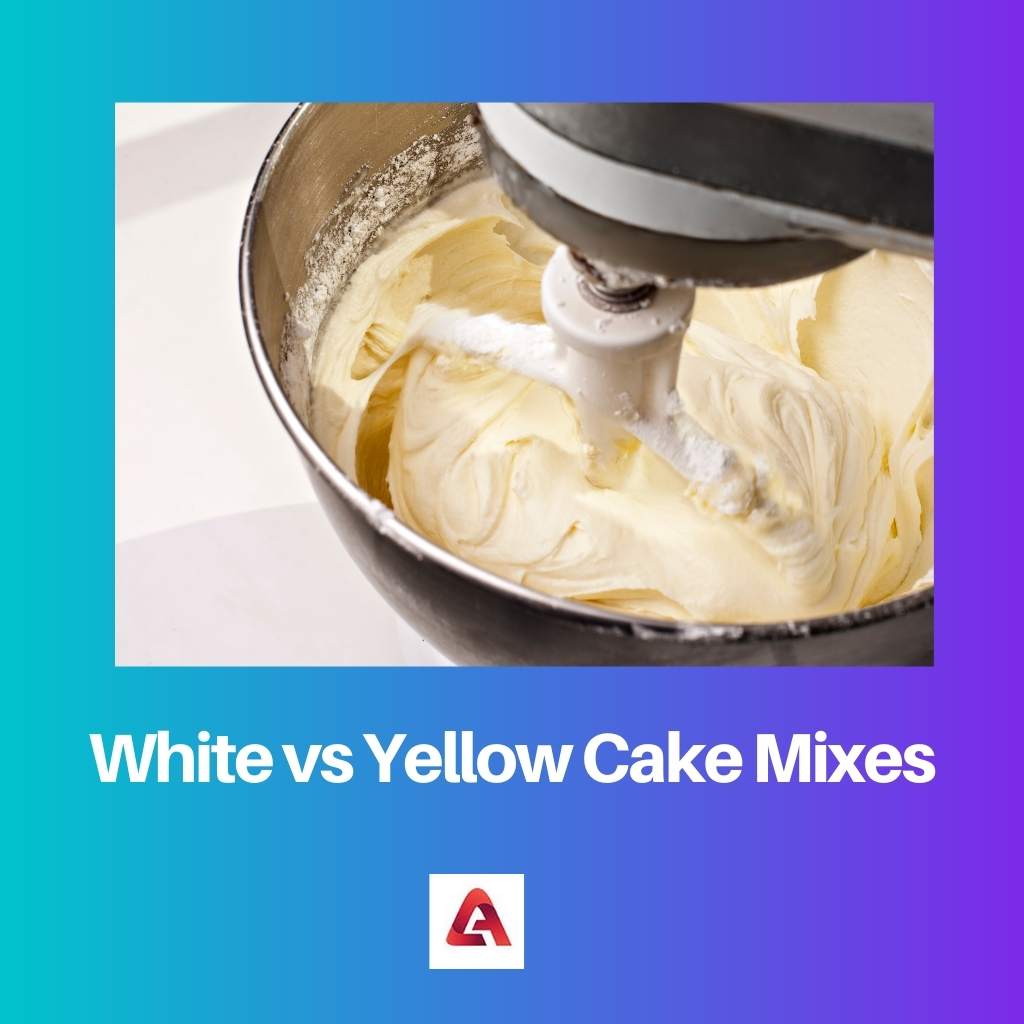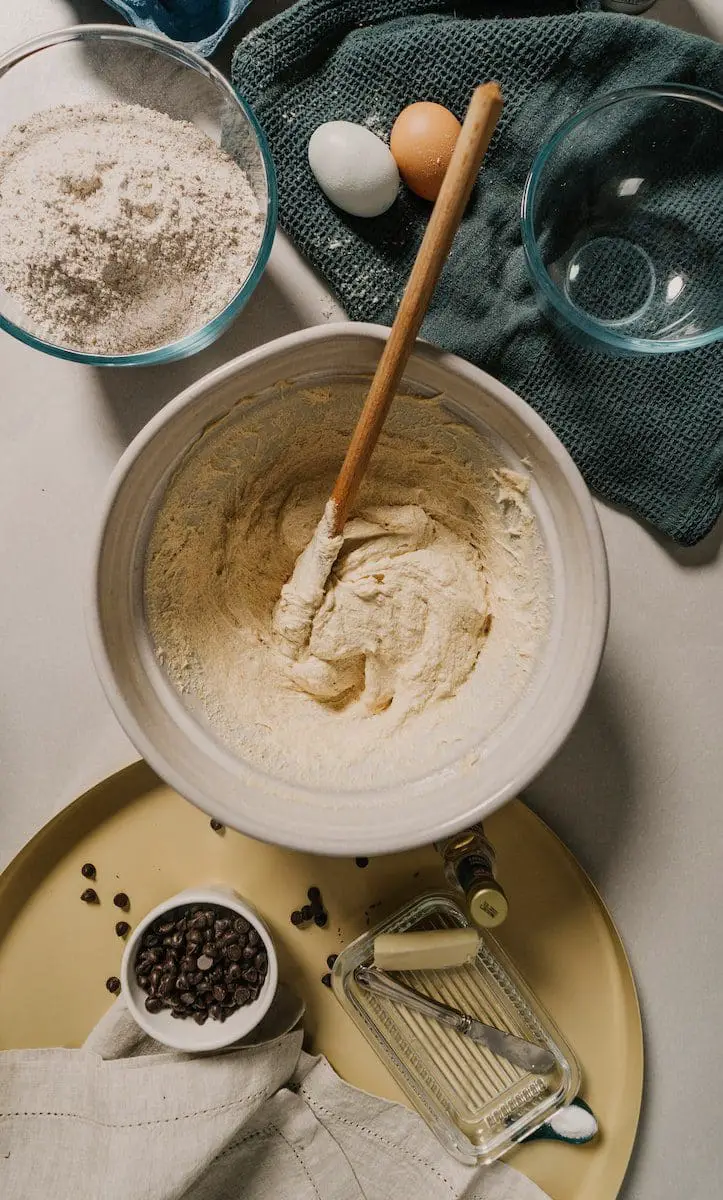White cake mixes typically use egg whites and a combination of vanilla and almond extracts, resulting in a lighter, fluffier texture with a subtle flavor. On the other hand, yellow cake mixes include whole eggs, offering a richer taste and a slightly denser crumb.
Key Takeaways
- White cake mixes are made with only egg whites, while yellow cake mixes are made with whole eggs.
- White cake mixes have a lighter, more delicate texture than yellow.
- Yellow cake mixes have a richer flavor than white cake mixes.
White vs Yellow Cake Mixes
White cake mixes include corn starch, and yellow cake mixes are made up of bleached all-purpose flour in case of dry ingredients. In wet ingredients, white cakes contain only egg whites, thus making a thin concoction, while yellow cakes include whole eggs with a thicker batter. Both cake mixes are vanilla flavoured.

White Cake Mix is a white-colored mix mostly used for the base of the cupcake with icing and toppings. It is baked at 370-375 degrees for a maximum of 35 minutes.
Yellow Cake Mix is a yellow-colored mix used; this type of mix is also preferred with any icing or fillings. And like white cake mix, it also has the flavour of vanilla.
Comparison Table
| Feature | White Cake Mix | Yellow Cake Mix |
|---|---|---|
| Color | Pure white | Light yellow |
| Key Ingredients | * Egg whites only * Shortening or vegetable oil (for neutral color) * Cake flour (may contain cornstarch) | * Whole eggs * Butter * All-purpose flour |
| Texture | Lighter, airier, spongier | Denser, moister, slightly chewier |
| Flavor | Subtle sweetness, neutral base for bold frostings and fillings | Vanilla flavor, richer taste |
| Typical Uses | Wedding cakes, birthday cakes decorated with fondant, fruit fillings and lighter frostings | Vanilla cupcakes, sheet cakes, layered cakes with chocolate or caramel frostings |
What are White Cake Mixes?
White cake mixes are pre-packaged, convenient baking mixes designed to simplify the process of making white cakes. These mixes are a popular choice for both novice and experienced bakers, offering a quick and easy solution to achieve a light and fluffy white cake without the need for measuring and combining individual ingredients.
Composition
1. Flour Blend
White cake mixes typically contain a pre-sifted blend of all-purpose flour or cake flour. This ensures a consistent texture and helps achieve the desired lightness in the final cake.
2. Sugar
Granulated sugar is a key ingredient in white cake mixes, providing sweetness and contributing to the cake’s moist and tender crumb.
3. Leavening Agents
Baking powder and/or baking soda are incorporated into the mix to facilitate the rising of the cake during baking, resulting in a soft and airy texture.
4. Fat
Vegetable shortening or oil is often included to add moisture and contribute to the cake’s tenderness. Some recipes may also call for the addition of butter for flavor.
5. Flavorings
To enhance the flavor profile, white cake mixes may contain vanilla extract or other flavorings. This ensures a delicious and well-balanced taste in the finished cake.
6. Stabilizers and Emulsifiers
Ingredients like egg whites, milk solids, or emulsifiers may be present to improve the cake’s structure and stability.
Convenience and Time-Saving
White cake mixes are known for their convenience, making them an ideal option for busy individuals or those new to baking. The pre-measured and pre-mixed ingredients save time, reduce the risk of error, and eliminate the need to keep various baking staples on hand.
Versatility
These cake mixes serve as a versatile base for customization. Bakers can add their own creative touches, such as incorporating additional flavorings, extracts, or mix-ins like fruits or nuts, to personalize the cake according to their preferences.
Common Uses
White cake mixes are commonly used to create a variety of desserts, including layered cakes, cupcakes, and sheet cakes. They serve as a blank canvas for a range of frostings, fillings, and decorations.
Tips for Success
- Follow Instructions: While the convenience of cake mixes is undeniable, it’s crucial to follow the provided instructions for the best results.
- Room for Creativity: Experiment with add-ins and frosting options to customize the cake to your liking.
- Check Freshness: Ensure the mix is within its expiration date to guarantee optimal taste and texture.

What are Yellow Cake Mixes?
Yellow cake mixes are pre-packaged, convenient baking mixes designed to simplify the process of making yellow cakes. These mixes are a popular choice for home bakers who want to save time and effort while still enjoying the delicious taste of a homemade cake. In this overview, we’ll delve into the key aspects of yellow cake mixes.
What is a Yellow Cake?
A yellow cake is a type of sponge cake characterized by its light, fluffy texture and golden-yellow color. It typically contains basic ingredients such as flour, sugar, butter, eggs, and baking powder. Yellow cakes are versatile and serve as a base for various frosting and flavor combinations.
Yellow Cake Mix Components
Yellow cake mixes typically include the dry ingredients needed to make a yellow cake. The key components are:
1. Flour
The primary foundation of any cake mix, flour provides the structure and texture to the yellow cake. It is a key ingredient in creating the cake’s crumb.
2. Sugar
Sugar sweetens the cake and contributes to its tenderness by retaining moisture. It also plays a role in the cake’s browning during baking.
3. Leavening Agents
Yellow cake mixes contain leavening agents like baking powder or baking soda. These agents help the cake rise, creating a light and airy texture.
4. Flavorings
To enhance the flavor, vanilla extract or artificial flavorings are often included in yellow cake mixes. This ensures a tasty and aromatic end product.
5. Stabilizers
Some mixes may include stabilizers like xanthan gum or modified food starch to improve the cake’s structure and prevent it from collapsing.
Preparation Process
Yellow cake mixes are known for their simplicity in preparation. The general steps include:
1. Mixing Dry Ingredients
Combine the yellow cake mix with wet ingredients such as eggs, water, and oil. Mix until the batter is smooth and free of lumps.
2. Baking
Transfer the batter to a greased baking pan and bake according to the instructions on the mix packaging. This step ensures the cake rises and cooks evenly.
3. Cooling and Frosting
Allow the baked cake to cool before applying frosting or other toppings. This ensures that the frosting adheres properly and doesn’t melt.
Variations and Customizations
Yellow cake mixes serve as a versatile base for various flavor and ingredient additions. Bakers can customize their cakes by incorporating ingredients like chocolate chips, nuts, or fruit, adding a personal touch to the final product.

Main Differences Between White and Yellow Cake Mixes
- Ingredients:
- White cake mix typically uses only egg whites or a combination of whole eggs and egg whites, resulting in a lighter color.
- Yellow cake mix uses whole eggs or egg yolks, giving it a yellow tint and a richer flavor.
- Flavor Profile:
- White cake has a more subtle flavor, allowing for versatile pairing with various frosting and filling options.
- Yellow cake has a buttery and slightly richer flavor due to the inclusion of egg yolks.
- Texture:
- White cake tends to have a lighter and fluffier texture, making it a good choice for layered cakes.
- Yellow cake is often denser and more moist, suitable for cupcakes and sheet cakes.
- Versatility:
- White cake is a neutral canvas, making it adaptable to different flavors and fillings without overpowering them.
- Yellow cake has a distinct flavor that can complement a variety of frostings, especially those with caramel or chocolate undertones.
- Visual Appeal:
- White cake provides a clean and pure appearance, making it ideal for weddings and formal occasions.
- Yellow cake adds a warm and inviting color to desserts, making it well-suited for birthdays and casual gatherings.
- Traditional Associations:
- White cake is often associated with elegance and weddings.
- Yellow cake is a classic choice for birthday cakes and comfort desserts.
- Popular Pairings:
- White cake pairs well with fruit fillings, citrus flavors, and light frostings like vanilla or almond.
- Yellow cake complements chocolate, caramel, and buttercream frostings, enhancing its rich taste.

- https://www.jstor.org/stable/41983105
- https://meridian.allenpress.com/jfp/article-abstract/70/4/997/172549
- https://onlinelibrary.wiley.com/doi/abs/10.1111/j.1745-459X.1993.tb00202.x
- https://pubs.rsc.org/no/content/articlehtml/2009/ja/b821405k
- http://cardinalscholar.bsu.edu/handle/handle/185556
The article does an excellent job of explaining the differences between white and yellow cake mixes. It provides great insights into the reasons behind their unique characteristics.
I’ve learned a lot from the article, especially with the comprehensive details in the comparison table. Thank you!
This article was very informative with its detailed discussion on the composition and differences of white and yellow cake mixes. It’s a great help for people who want to improve their baking skills.
The article gives an in-depth and informative portrayal of the differences between white and yellow cake mixes. The comprehensive discussion is truly enlightening.
The article provides a very educational and comprehensive comparison between white and yellow cake mixes, which I find very useful. It’s a great reference material for anyone interested in baking.
I appreciate the detailed explanation of the baking process, as well as the use of white and yellow cake mixes. This information is extremely helpful and well-presented.
The detailed discussion of the specific characteristics of white and yellow cake mixes is truly enlightening. The comparison table makes it easy to understand their differences.
This article provides an excellent discussion of white and yellow cake mixes, their unique characteristics, and practical applications. Great source of valuable information for bakers.
The article is excellent. The details about the specific ingredients, nutritional value, and practical advice regarding baking a cake are quite useful for bakers. Truly informative!
Thank you for the clearly presented comparison between white and yellow cake mixes. The references provided further emphasize the reliability of the information presented.